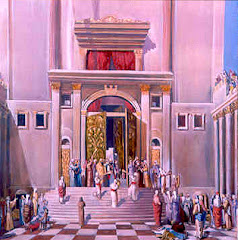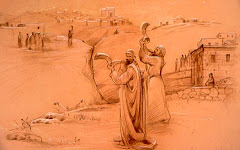RABBI NECHEMYA MOTA - AN INDIAN KABBALIST:
INTRODUCTION:
Not much information can be found on the kabbalist,
R. Nechemya ben Avraham Mota (d. 1575[1]),
although what little can be gleaned about him and
his community is intriguing. He is also known as
theTzadik of Cochin, a town in the tropical area of
Kerala (meaning coconut) in southwest India.
R. Nechemya ben Avraham Mota (d. 1575[1]),
although what little can be gleaned about him and
his community is intriguing. He is also known as
theTzadik of Cochin, a town in the tropical area of
Kerala (meaning coconut) in southwest India.
BACKGROUND:
SHANIVAR TELI:
The Bene Yisrael or Shanivar Teli caste of Indian Jews
is quite well known and well documented. They inhabited
the central western coastline of India and later moved
to Mumbai and parts of today’s Pakistan.
is quite well known and well documented. They inhabited
the central western coastline of India and later moved
to Mumbai and parts of today’s Pakistan.
Rambam (1135-1204) mentions that there were Jews
living in India, and it is generally understood that he
may have been referring to the Bene Yisrael.[2]
living in India, and it is generally understood that he
may have been referring to the Bene Yisrael.[2]
But there was another group of Jews that lived in Cochin,
about which not much is known:
about which not much is known:
THE JEWS OF COCHIN:
According to Nathan Katz[3], a Jewish community has
existed in Cochin for about two thousand years. During
that time, they experienced peace and prosperity while
participating actively in the spice trade, government
and even the military. At one stage, besides enjoying an
autonomous Jewish principality, there was even a Jewish
prime minister to a Hindu Maharaja.
existed in Cochin for about two thousand years. During
that time, they experienced peace and prosperity while
participating actively in the spice trade, government
and even the military. At one stage, besides enjoying an
autonomous Jewish principality, there was even a Jewish
prime minister to a Hindu Maharaja.
According to some accounts, Jewish sailors started arriving
in southwest India from the time of King Solomon. Other
accounts suggest that Jews came there during the Babylonian
Exile around 500 BCE, or after the destruction of the
Second Temple around 70 CE. Still other accounts put it
during the 4th-centurymigration from Majorca. And according
to a traditional song sung by some Malayam Jews, their
ancestors came from Yemen.
in southwest India from the time of King Solomon. Other
accounts suggest that Jews came there during the Babylonian
Exile around 500 BCE, or after the destruction of the
Second Temple around 70 CE. Still other accounts put it
during the 4th-centurymigration from Majorca. And according
to a traditional song sung by some Malayam Jews, their
ancestors came from Yemen.
Either way, the Jewish community developed their own style
of liturgy, known as nusach Shingly, after the ancient centre
of Cranganore, north of Cochin, which the Jews called Shingly.
In 1341 a flood changed the coastline and the port of Cranganore
was silted up and a new harbour opened up in Cochin.
The Jews then moved to Cochin.
of liturgy, known as nusach Shingly, after the ancient centre
of Cranganore, north of Cochin, which the Jews called Shingly.
In 1341 a flood changed the coastline and the port of Cranganore
was silted up and a new harbour opened up in Cochin.
The Jews then moved to Cochin.
The Cochin Jews were never a homogenous group since they
descended from Jews of various cultural backgrounds. There
were three separate synagogues (the Tekkumbagam, Paradesi
and Tekkavumbagam Synagogues) all within walking distance
of each other in what was called later referred to as ‘Jew Town’.
descended from Jews of various cultural backgrounds. There
were three separate synagogues (the Tekkumbagam, Paradesi
and Tekkavumbagam Synagogues) all within walking distance
of each other in what was called later referred to as ‘Jew Town’.
The oldest documentary evidence of this community goes back
to 1000CE, when one Yosef Rabban received some engraved
copper plates from the Hindu ruler exempting the Jews from
paying taxes, and allowing them to collect tolls and use drums
and lamps - which was considered an honourable ritual status.
These plates are apparently still preserved in the Paradesi
Synagogue in Cochin.
to 1000CE, when one Yosef Rabban received some engraved
copper plates from the Hindu ruler exempting the Jews from
paying taxes, and allowing them to collect tolls and use drums
and lamps - which was considered an honourable ritual status.
These plates are apparently still preserved in the Paradesi
Synagogue in Cochin.
The Maharaja gave the Jews a large portion of land which
was named Mattancherry, right next to his palace. Mattancherry
is a mixture of Hebrew and Malayalam, meaning Gift of Land.
was named Mattancherry, right next to his palace. Mattancherry
is a mixture of Hebrew and Malayalam, meaning Gift of Land.
In this far corner of the world, the Jews developed their own
language which was a mixture of Hebrew and Malayalam
and produced a number of rabbis and even kabbalists who
enjoyed the rather unique distinction of being revered by Hindus,
Muslims and Christians.
language which was a mixture of Hebrew and Malayalam
and produced a number of rabbis and even kabbalists who
enjoyed the rather unique distinction of being revered by Hindus,
Muslims and Christians.
The Cochin Jews probably developed the most exotic religious
practices in the Jewish world, as – living in India – they became
an elite caste and also adopted some Hindu symbols. Unfortunately,
the caste system created some friction within the Jewish community
as Jews discriminated amongst themselves and in one particular case
a caste controversy waged for five hundred years.
practices in the Jewish world, as – living in India – they became
an elite caste and also adopted some Hindu symbols. Unfortunately,
the caste system created some friction within the Jewish community
as Jews discriminated amongst themselves and in one particular case
a caste controversy waged for five hundred years.
When Israel attained independence in 1948, a year after Indian
became independent, most of the Cochin Jews immigrated to Israel.
Today there are about four thousand Cochin Jews in Israel.
became independent, most of the Cochin Jews immigrated to Israel.
Today there are about four thousand Cochin Jews in Israel.
Although there are only about sixty (some say twenty-six) Jews still
there today, it is estimated that many thousands of Jews once lived in
that fertile area of the Malabar coast of Kerala.
there today, it is estimated that many thousands of Jews once lived in
that fertile area of the Malabar coast of Kerala.
THE PARADESI SYNAGOGUE:
During the 16th-century, there was a new wave of Jewish
migration to Kerala,
with many refugees from the Spanish and Portuguese expulsions.
These new immigrants were known as Paradesis or foreigners.
They built their own Paradesi Synagogue just thirty yards from
the Maharaja’s palace in Cochin. These newcomers were also
referred to as ‘white Jews’ as opposed to the original Jewish
inhabitants who were called ‘black Jews’. The Paradesi Jews
did not intermarry with the original Jews.
migration to Kerala,
 |
| The Paradesi Synagogue today. |
with many refugees from the Spanish and Portuguese expulsions.
These new immigrants were known as Paradesis or foreigners.
They built their own Paradesi Synagogue just thirty yards from
the Maharaja’s palace in Cochin. These newcomers were also
referred to as ‘white Jews’ as opposed to the original Jewish
inhabitants who were called ‘black Jews’. The Paradesi Jews
did not intermarry with the original Jews.
The Paradesi Synagogue has a three-story clock tower
(added in 1761) with three faces. The side which faces the
Maharaja’s palace has Malayalam characters, while the side
facing Jew Town has Roman characters and the side facing
the synagogue has Hebrew characters.
(added in 1761) with three faces. The side which faces the
Maharaja’s palace has Malayalam characters, while the side
facing Jew Town has Roman characters and the side facing
the synagogue has Hebrew characters.
Visitors must remove their shoes before entering these synagogues
in keeping with the Hindu and Muslim practice. Removing shoes
before entering a synagogue was also a custom in Yemen (and the
Talmud Yerushalmi records that it was also the custom in Israel –
although not in Babylonia[4]).
in keeping with the Hindu and Muslim practice. Removing shoes
before entering a synagogue was also a custom in Yemen (and the
Talmud Yerushalmi records that it was also the custom in Israel –
although not in Babylonia[4]).
One of the silver crowns on the Sefer Torah was a gift from the
Maharaja in 1803. In 1968 the Paradesi Synagogue celebrated
its 400 anniversary and the celebration was attended by Prime
Minister Indira Gandhi. A commemorative stamp was also issued.
Maharaja in 1803. In 1968 the Paradesi Synagogue celebrated
its 400 anniversary and the celebration was attended by Prime
Minister Indira Gandhi. A commemorative stamp was also issued.
R. NECHEMYA MOTA:
Cochin Jews (known as Cochinim) commemorate the passing of
their kabbalist, R. Nechemya Mota, on the anniversary of his
death which is on the first day of Chanukah. He is also known
as Naamia Mootha.
their kabbalist, R. Nechemya Mota, on the anniversary of his
death which is on the first day of Chanukah. He is also known
as Naamia Mootha.
His tomb in Jew Town has become a place of pilgrimage not just for
Jews but also for Hindus, Muslims and Christians.
Jews but also for Hindus, Muslims and Christians.
Stories abound of his miraculous deeds including his alleged ability
to fly through the air to reach his home before Shabbat prayers.
to fly through the air to reach his home before Shabbat prayers.
The first English reference to Nechemya Mota was in the 1907
edition of the Jewish Encyclopaedia, which states that he was a
false messiah who appeared to the Jews of Cochin. This has
subsequently been contested but of course, the entry
(and hence the allegation)
still remains.
edition of the Jewish Encyclopaedia, which states that he was a
false messiah who appeared to the Jews of Cochin. This has
subsequently been contested but of course, the entry
(and hence the allegation)
still remains.
Most scholars seem to think he hailed from Yemen, although some
believe he came from Italy or even Poland. He married a woman
from the original or ‘black Jewish’ community.
believe he came from Italy or even Poland. He married a woman
from the original or ‘black Jewish’ community.
The 1757 nusach Shingly Machzor, contains around twenty of
Nechemya Mota’s prayers – but for some reason, they were
omitted from the 1769 edition. In more recent editions, printed
in Israel, they were reincorporated back into the Shingly nusach.
Nechemya Mota’s prayers – but for some reason, they were
omitted from the 1769 edition. In more recent editions, printed
in Israel, they were reincorporated back into the Shingly nusach.
The following is an English translation of the inscription
from his headstone:
from his headstone:
“Here rest the remains of
the famous kabbalist,
The influence of the light of whose learning
shines throughout the country,
The perfect sage, the hasid, and
God-fearing Nehemia, the son of
The dear rabbi and sage Abraham Mota.
Our Master departed this life on
Sunday, the 25th of Kislev, 5336 (1575).
May his soul rest in peace.”
Source:
https://kotzkblog.blogspot.com/2018/09/194-rabbi-nechemya
-mota-indian-kabbalist.html (amazing blog)
https://kotzkblog.blogspot.com/2018/09/194-rabbi-nechemya
-mota-indian-kabbalist.html (amazing blog)












